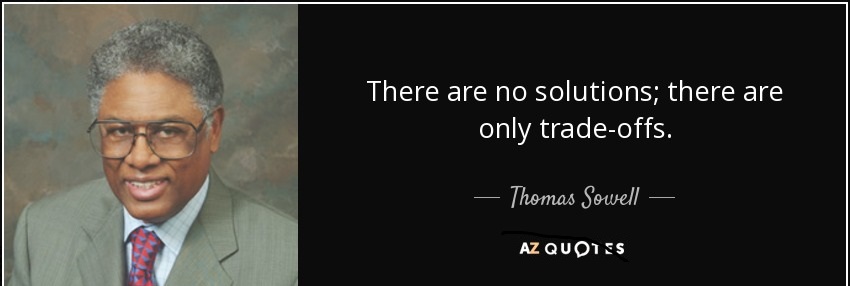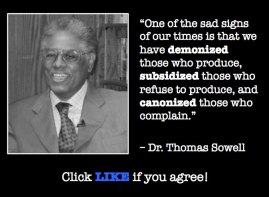Thomas Sowell is a great economist, but his expertise extends to other fields of study. Everything from history to education.
But he’s also famous for being a great communicator, with dozens of well-known quotes.
 I use one of them on my rotating banner because it succinctly summarizes why the left has to rely on emotional appeals rather than rigorous evidence.
I use one of them on my rotating banner because it succinctly summarizes why the left has to rely on emotional appeals rather than rigorous evidence.
For purposes of today’s column, I want to cite one of his other quotes, this one dealing with the fact that tradeoffs are an inevitable reality.
 Simply stated, if you want more of one thing, you have to accept less of another thing.
Simply stated, if you want more of one thing, you have to accept less of another thing.
And this has important implications for regulatory policy – especially about the value of cost-benefit analysis.
Let’s look at two examples.
First, here’s the abstract from a study by Jordan Nickerson from MIT and David Solomon from Boston College.
Since 1977, U.S. states have passed laws steadily raising the age for which a child must ride in a car safety seat. These laws significantly raise the cost of having a third child, as many regular–sized cars cannot fit three child seats in the back. Using census data and state–year variation in laws, we estimate that when women have two children of ages requiring mandated car seats,
they have a lower annual probability of giving birth by 0.73 percentage points. Consistent with a causal channel, this effect is limited to third child births, is concentrated in households with access to a car, and is larger when a male is present (when both front seats are likely to be occupied). We estimate that these laws prevented only 57 car crash fatalities of children nationwide in 2017. Simultaneously, they led to a permanent reduction of approximately 8,000 births in the same year, and 145,000 fewer births since 1980, with 90% of this decline being since 2000.
This raises all sorts of challenging questions, such as what’s the value of a life saved compared to the value of lives that might have existed (a philosopher might have a different answer than an actuary at the Social Security Administration!).
And let’s not forget that you seemingly could save more lives if there were mandatory 5-mph speed limits, but that policy also has tradeoffs that could produce more deaths elsewhere.
For what it’s worth, I think parents should get to decide whether they need a car seat for a 7-year old (and thus have more children), but I’m not going to pretend there are no negative consequences.
Let’s look at another example.
In a post for Marginal Revolution, Prof. Alex Tabarrok of George Mason University points out that you can save lives in India by selling cars with abysmally low safety ratings.
These cars are very inexpensive. A Renault Kwid, for example, can be had for under $4000. In the Indian market these cars are competing against motorcycles. Only 6 percent of Indian households own a car but 47% own a motorcycle. Overall, there are more than five times as many motorcycles as cars in India. Motorcycles are also much more dangerous than cars.
…The GNCAP worries that some Indian cars don’t have airbags but forgets that no Indian motorcycles have airbags. Even a zero-star car is much safer than a motorcycle. Air bags cost about $200-$400…and are not terribly effective. (Levitt and Porter, for example, calculated that air bags saved 550 lives in 1997 compared to 15,000 lives saved by seatbelts.) At $250, airbags would increase the cost of a $5,000 car by 5%. A higher price for automobiles would reduce the number of relatively safe automobiles and increase the number of relatively dangerous motorcycles and thus an air bag requirement could result in more traffic fatalities.
Unlike the issue of car seats for kids, there’s no moral ambiguity on this topic.
Indians should be allowed to buy “unsafe” cars because there will be far fewer fatalities and serious injuries.
By the way, cost-benefit analysis is not a panacea. Benjamin Zycher of the American Enterprise Institute wrote a few years ago that such analysis can be counterproductive if you have a biased and ideologically driven bureaucracy such as the Environmental Protection Agency.
But even halfway competent and fair cost-benefit analysis would be very helpful in the world of public policy.
- It would tell us that it makes no sense to raise tax rates to the point where governments collect little or no revenue.
- It would tell us that the negative effects of drug prohibition are likely greater than the negative effects of legalization.
- It would tell us anti-money laundering policies are far more likely to hurt poor people rather than to catch criminals.
Then again, politicians and bureaucrats probably have incentives to not produce that kind of information..








